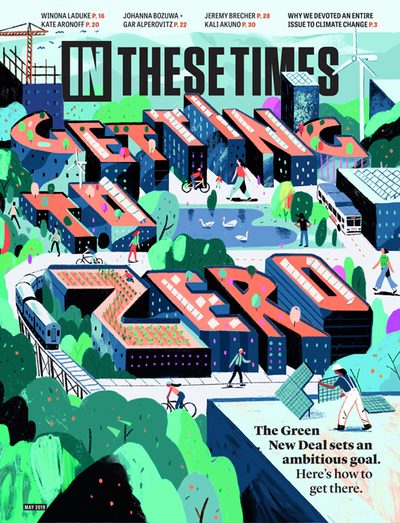We Produce Too Much Food. The Green New Deal Can Stop This.
Overproduction spurs environmental degradation while the poor get left behind.
Eric Holt-Giménez

U.S. Secretary of Agriculture Sonny Perdue has called climate change “a running joke.” Farmers, meanwhile, are reeling from droughts, floods, heat waves, cold snaps and pest outbreaks unleashed by global warming.
Agriculture is not just a victim, however, but a perpetrator. The Environmental Protection Agency estimates that agriculture emits 9 percent of the country’s greenhouse gases — mostly nitrous oxide from fertilizer and methane from livestock. Globally, this number is higher (roughly a quarter) and expected to rise, primarily because of projected increases in meat and vegetable oil production to supply a growing, middle-income market.
It’s impossible to avoid the climate crisis in the countryside, but there is profound disagreement on what to do. In one camp are the large-scale, capital-intensive farms, concentrated animal feeding operations (CAFOs) and agribusiness oligopolies — for them, the solution is an intensification of industrial agriculture.
In the other camp is what’s known as agroecology, an approach inspired by scientific research and indigenous practices showing how to work with the land’s ecology. Agroecology informs many farming styles today, including organic farming, permaculture, agroforestry and regenerative agriculture.
Let’s take these two methods one at a time.
The industrial approach rests on the conventional (and contested) belief that only the large-scale industrial food system can feed the world. (Never mind that this same system destroys soil, habitat and species, and that organic, small-scale farms can be as or more productive.) Adherents have spent the last half century trying to eradicate or assimilate all other forms of agriculture into this energy intensive, water-guzzling, emissions-generating production model.
Now, bruised and disoriented by global warming, their primary objective is to maintain the system through what they call “climate-smart agriculture”: reducing emissions and increasing productivity on existing plantations, largely through technological fixes such as drought-tolerant seeds and more precise application of inputs. But the results aren’t always positive. The country’s vast soy and corn plantations, for example, can label themselves “climate smart” for bringing down fertilizer costs, even as the crops they produce go on to feed cows and pigs in methane-spewing CAFOs. Increasing productivity in one link of the grain/livestock supply chain can drive further emissions elsewhere — “climate-smart ag” driving “climate-stupid consumption.”
At bottom, so-called climate-smart agriculture leaves the existing industrial food system — a system based on CAFOs and chronic overproduction — intact. Overproduction is what drives the unrestrained use of chemicals, the drawdown of ancient aquifers, and the high levels of agricultural pollution (including greenhouse gases). Overproduction leads to underpriced commodities, which allows the grain, meat and retail giants to buy on the cheap and turn a large profit, firming up their monopoly power — no matter the real cost to farmers, taxpayers (who subsidize grain production) or the environment.
The rationale for industrial overproduction is to “feed the world” by doubling food production by 2050, as one UN panel called for. But the world has been producing more than enough food to feed every human being for half a century. People don’t go hungry because food is scarce, but because they are too poor to buy the food being produced. Producing so much food just drives prices even lower, running smaller farmers out of business. In developing countries, these farmers join the ranks of the hungry — a cruel irony behind the call to “feed the world.” In the United States, one of the richest countries in the world (and the third-largest food producer after China and India), one in eight people are food insecure — with the largest numbers in rural areas and among farm and food workers.
The alternative to the industrial food system is agroecology, the “science of sustainable agriculture,” developed over 70 years ago when ecologists and anthropologists observed highly productive, millennia-old forms of traditional agriculture in Asia and Latin America that sustainably produced food and fiber. Research shows these methods could not only produce enough food, but do so while restoring — rather than destroying — the planet’s ecosystems.
Cover crops and mulch, for instance, are used to protect and maintain fertile, organic soils, in place of nitrous-oxide-emitting fertilizer. In fact, the diversified farming system — made up of a variety of plants and, often, livestock — ultimately captures and stores carbon in the ground. Other techniques avoid petrochemical-based pesticides by planting crops that repel insect pests or attract birds and insect predators, nature’s pest control.
Vastly outgunned in the market, underfinanced in research and drowned out of Washington by agribusiness lobbies, agroecology has been marginalized from mainstream debates on climate adaptation and mitigation in the United States. That is, until the Green New Deal blasted open the conversation on climate change, agriculture and equity, voicing vague but encouraging support for “family farming” as well as “sustainable … practices that increase soil health.”
Like the original New Deal, the Green New Deal follows decades of laissez-faire, free-market capitalism, massive concentrations of wealth, devastating financial crashes and environmental catastrophe (the New Deal had the Dust Bowl — the Green New Deal has global warming).
The first New Deal implemented the Agricultural Adjustment Act to keep farmer incomes steady by controlling overproduction. It levied taxes on processors and middlemen, stored excess grains in national reserves (selling them when supply got low) and paid farmers not to grow more than was needed in order to ensure “parity prices” — that is, food commodity prices that covered the cost of production. This meant farmers were not forced “to overproduce their way out of poverty and debt,” as Iowa farmer George Naylor explains. “It was understood that the farmer’s individual ‘freedom’ to do whatever he or she wished with the land would be tempered for the good of all farmers and society. A social contract was established.” The Green New Deal provides an opportunity to establish a new social contract today to once again prevent agricultural overproduction.
Imagine a contract in which a farmer is ensured a parity price if their farm uses agroecological methods and does not overshoot environmentally sound levels of production — does not mine the soil, pollute the air and waterways, or extract more water and resources than can be seasonally replenished. These farmers would not have to overproduce to stay in business. They could set more land aside for conservation and forests, to capture carbon and provide home to wildlife. Or they could raise grass-fed livestock, which, under certain conditions, can sequester enough carbon in the soil to offset methane emissions. They could afford to pay farmworkers (and themselves) a fair wage for their highly skilled labor.
Meanwhile, government could stop subsidizing cheap grains and meat. In fact, stricter regulation could put a price on pollution and squeeze CAFOs out of business.
President Franklin D. Roosevelt was able to implement the New Deal despite opposition from entrenched corporate interests because there was a groundswell of support from farmers’ unions, labor unions and the citizenry suffering under the Great Depression. To beat opposition from Big Ag, the Green New Deal will need endorsements from frontline organizations in the food, farm and climate justice movements. That support will largely hinge on the participation of these communities — many of which are already advocates and practitioners of agroecology — in the actual drafting of legislation.
Clearly, the Trump administration is neither willing nor capable of taking on Big Ag. But the Green New Deal could be the catalyst to build the broad-based, working-class, multicultural movement needed to vote the bums out and bring Green New Dealers in. Then we need to make them do the right thing — starting with a new social contract for farmers.





